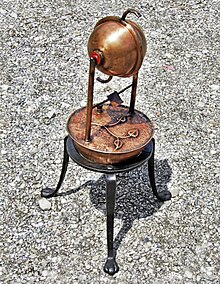Herons Ball
The aeolipile (also Äolsball , Aeolipile or aeolipile called) is one of Heron of Alexandria described machine , the expansion force of water vapor and the reaction principle demonstrated. The aeolipile had previously been known to ancient Egyptian priests.
The Heronsball is one of the first heat engines that have been handed down in writing . It had no practical use in antiquity and was viewed as a curiosity. Heron of Alexandria described in his work Pneumatika not only the Heron's ball but also practical heat engines in the form of automatic temple doors.
description
The lower part of the machine is a sealed kettle that can be heated from below with an open flame. At the top there is a ball which is rotatably mounted in its holder and to which two outlet nozzles are attached. One of the two brackets serves as a tube through which water vapor can enter the upper sphere from the lower part. If you bring the water in the lower vessel to a boil, water vapor flows through the holder into the ball and leaves it through the two nozzles. This creates a recoil that causes the ball to rotate.
From a technical point of view, it is a reaction turbine .
See also
literature
- Heinrich Wilhelm Schaefer : Αἰόλου πύλαι . In: Paulys Realencyclopadie der classischen Antiquity Science (RE). Volume I, 1, Stuttgart 1893, Sp. 1042.
- Armin Hermann, Charlotte Schönbeck (Ed.): Technology and Science , 1991, p. 385 f.
Web links
Individual evidence
- ↑ Aurel Stodola (ed.): The steam turbines . Springer, 1910, p. 1 ( archive.org [accessed June 9, 2014]).
- ↑ Heron's steam drive. In: LEIFIphysik.de. Joachim Herz Foundation, accessed on May 3, 2018 .
- ↑ B. Wamister: Control system Fuzzy. In: docplayer.org. May 17, 1998, p. 1 , accessed May 3, 2018 .
- ^ Wilhelm Schmidt (ed.): Herons of Alexandria printed works and automat theater . Teubner, 1899, p. 230 (Greek, archive.org [accessed April 28, 2014]).


